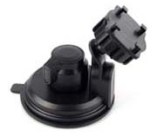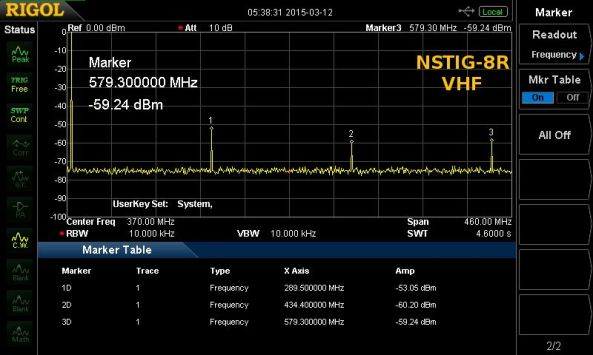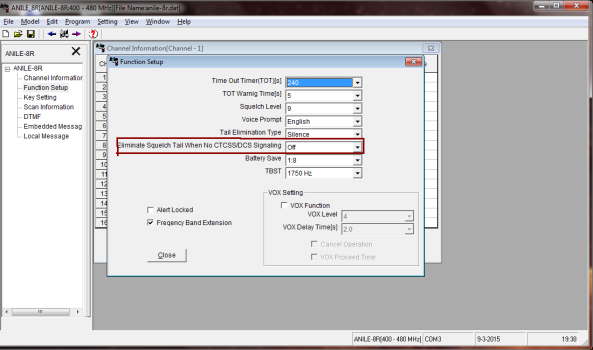Posts Tagged ‘Anytone Tech’
 Review – BTech DMR-6X2
Review – BTech DMR-6X2
Several Dual Band DMR handhelds have been introduced into the market in the past few months. Having owned most of them, I would have to place this one toward the very top of the list. The DMR-6X2 is both VHF and UHF, Tier II DMR digital as well as FM analog with most features geared strictly toward ham radio use.
Important Note: The BTech DMR-6X2 is Not made by Baofeng. (see note below). That being said, let’s see what’s…
In the Box
Included with the radio are the:
– Two (2) Li-Ion Batteries (2100 and 3100 mAh)
– Two (2) Belt clips
– Hand Strap
– 37 page User Guide – English
– Charger base & AC adapter
– Antenna – 6.25″ (16cm)
– Programming Cable
– Earphone / Microphone
General Description
– DMR / FM
– VHF / UHF Dual Band
– Size: 5.1 x 2.4 x 1.5″ (129 x 61 x 39mm)
– Weight: 9.9oz (282g) w/ant & 2100 mAh battery
– Weight: 10.8oz (306g) w/ant & 3100 mAh battery
– 136-174 400-480 MHz
– CTCSS/DCS DTMF/2TONE/5TONE
– Digital Simplex Repeater
– <1.0w / 6.0w transmit
– 4000 channel
– 250 Zones (up to 250 channels per zone)
– 10,000 contacts
– 150,000 DMR Database Contacts
– Part 90 compliant – 2AGND-DMR6X2
– N0GSG Contact Manager Compatible
Basic Description (additional features)
The heart of the 6X2 is the proven Anytone D868. Under contract with Anytone, BTech had several addition features exclusively added to the 6X2.
Some of the additional features exclusive to the 6X2 include:
– Multiple Scan Groups
– Priority Scan
– Change TG via Keypad (Adhoc) with Unlimited Hold Timer
– Display Color Options
– Digital Simplex Repeater
– Analog Squelch Level Adjustment
– Start Up Code Plug Compatibility
– Display Hold
– Multiple Scan Groups in Same Channel
The 6X2 allows multiple scan lists to be entered per channel. You are no longer limited to one scan group entry per channel. The scan groups can include and mix of DMR or analog channels.
– Priority Scan
When developing a scan list, up to 2 channels can be assigned as priority. This allows the priority channels to be interwoven in the scan list. As an example:
– Channel 1
– Priority Channel 1
– Channel 2
– Priority Channel 1
– Channel 3
– Priority Channel 1
– Change Group via Keypad (“Unlimited” hold timer)
This is specially nice when using a hot spot. By setting a key function to “Dial” or “Long Press 0”, and the Group Call Hold time to “Unlimited”, you can enter a Talk Group using the number pad and it will remain permanently or until the channel is changed. No longer is the hold time set in seconds or minutes.
– Display Color Options
There are two display color options available. They are White on Black background, and Black on a Powder Blue background. (shown below). They are selectable by either software or keypad menu.
– Analog Squelch Level Adjust
The analog squelch level can now be adjusted using one of the programmable keys.
– Start up Code Plug
To assist with start up, the software was written to initially accept an Anytone D868 code plug. I’ve had a 868 since they first came out, and this was a huge time saver. Everything transferred and I was ready to play radio in minutes.
Note: Due to the extra features in the code plug, a 6X2 CP cannot be transferred back to a D868.
– Digital Simplex Repeater
Not to be confused with a standard repeater, this feature allows the DMR-6X2 to function as a Store and Forward Simplex Repeater. The 6X2 records a transmission and stores it in memory. Immediately after the incoming signal is dropped, the transmitter keys and re-transmits the recorded audio. The re-transmission can be either on the same or different frequency (not necessarily on the same band).
This feature allows the 6X2 to be used as a relay point during events such as marathons, races, etc. where a central relay method is needed and there is no local repeater.
– Display Hold
When a signal is received, the data image (name, call, location, etc) remains on the screen until the next signal is received rather than drop back to a standby screen. There is a Call End indicator at the bottom, but the data remains.
The Technical Side of the 6X2
The Transmitter
The frequency range of the DMR-6X2 is both VHF 136-174 and UHF 400-480 MHz. Along with DMR, the radio also supports analog FM (Wideband and Narrowband)
The power levels hold pretty close to the specifications. There are four power levels with a high of 5.0W and a Turbo mode of 6.5W. I personally run mine in 5W mode. Turbo isn’t going to Make or Break the signal, but it helps the battery.
What I do like is the low power mode is less than 1W. I run a hotspot here and if the power was only 0.3W I would be happy.
My audio reports have been excellent both through a DMR hotspot and the local repeaters. There is a five level microphone gain parameter that allows you to select the microphone gain level that best suited for your voice. I use level 3 (mid-level) for a full smooth audio response. I tried level 5 and found the audio was way too hot.
Power levels are listed below and were taken using a calibrated Bird Termaline wattmeter.
Enclosure
The DMR-6X2 case has a good solid feel and weight, and fits the hand well. It weighs in at 9.9oz (282g) with the standard battery attached and 10.8oz (306g) with the high capacity battery. Battery removal requires a simple push of the release slide located at the top of the battery. No battery sliding or pushing is required.
I found the keypad buttons a bit larger than most with a lighted keypad layout of three across and four down. This puts the zero (0) at the bottom of the keypad where I believe it belongs. The PTT button requires only a light pressure that doesn’t tire the finger to press.
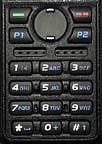
Antenna
The included dual band antenna is 6.25″ which is a fairly common size for a handheld. I found that there was a slight improvement of about 2db by using an NA-771. The 771 is 10″ longer, so a difference would be expected, but I’ll probably stay with the stock antenna.
Receiver and Audio
The receiver sensitivity is very good on both digital and analog. I found the receive audio is amazing with wide and smooth frequency range.
The volume control range is adjustable with the software. Level 1 sets the full range of the volume control to a soft level, even at full volume. Level 8 sets the volume range to very loud at the top end. My preference is level 3 to 5 which is plenty loud, even for mobile operation.
Display
The radio has a two multi-color display options. The high contrast White on Black, and the softer is a Powder Blue with multi-color icons. The color is selectable via software or as a keypad menu option. The screen size is 1.1″ x 1.4″ with excellent resolution .
There are multiple sites where the current DMR User Database can be downloaded. There are various formats available allowing you to view name, call, location, user ID, license class, etc.
.
Software
Along with entering data in the conventional manner, the software allows you to import and export data to ‘csv’ files. Loading in a contact (TG) list, channel list, database, etc. is relatively simple.
I found being able to export to a ‘csv’ file has several advantages. I like having my channel list in sequence. With most software, you can only add new channels to the bottom of the list. Now I can sequence the list so it’s easy to view then load it back into the code plug.
Adding a new repeater can be done in minutes. I just cut and paste a copy of an existing repeater, change the frequencies, and load it back.
Note: The BTECH 6X2 can import a code plug (.rdt) from an Anytone D868UV directly. This is a great way to get your 6X2 on the air. Once loaded, however, due to the expanded parameters, the D868 is not capable of reading a 6X2 code plug.
CSV transfer Caution
Adding large amounts of data, updating and re-sequencing via CSV files is a major plus, but should always be done with Caution. For instance, Talk Group data must always be loaded before or at the same time as the Channel data. If not, improper data attachment may not occur.
Always backup your current code plug before modification.
Firmware
As additional features and future enhancements are developed, the radio can be updated to latest model. A firmware upgrades can be done with a Windows computer in about 5 minutes.
Note: The DMR-6X2 firmware is specific to this radio. It cannot be uploaded to a different model in hopes of adding new features.
Programming Cable
The DMR-6X2 comes with the necessary programming cable. The UART chip inside the radio, so the cable itself is straight through. There is no circuitry inside the cable itself. The driver will load automatically when the cable is attached.
For reference, although the cable appears to be the same as some that have the chip in the cable, those cables are not compatible.
The charger base requires a standard 12vdc wall wart (included). The LED on the front of the charger base is Red when charging, and Green when either fully charged or no radio in the cradle. The battery easily charges to full capacity with an overnight charge.
Battery and Charger
There are two batteries included with the 6X2, a 2100mAh and a high capacity 3100mAh. With battery save on, I can get 2 to 3 days out of the 3100mAh battery before needing a charge.
There are also USB charging cables available with output of 12V. These can also be used in place of the included Wall Wart.
Conclusion
If you think the BTECH DMR-6X2 very closely resembles a D868UV, you are correct, but as shown above, it is definitely not simply a rebadged Anytone. There are features and enhancements that set these two radios apart. I think BTECH was wise to wait for the bugs to be ironed out before introducing the 6X2 to the market.
If you’re waiting for this radio to drop in price, don’t hold your breath. Its features and performance make it well worth the price.
The obvious pros are the following:
– True Tier II DMR
– Same Band and Cross Band digital simplex repeater
– Dual Band VHF/UHF operation
– Multiple Scan Groups per Channel
– Priority Scan
– On the Fly Talk Group Entry
– Built-in Voice Recorder
– 2TONE and 5TONE decoding
– 150K user database capacity
– FCC Part 90 certified for commercial use
– N0GSG Contact Manager Compatible
There are plenty of options geared more for hams than commercial use. It performs well and makes a nice addition to the ham shack.
Available from:  and Amazon
and Amazon
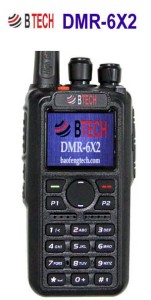
For Clarification
BTech (BaofengTech) is not a division of Baofeng. They are an ODM that partners with OEM manufacturers to spec and build to their own requirements, whether from scratch (UV-5X3) or from an existing product. This 6X2 is an Anytone at heart with additional unique features found only in that model.
Here’s a comparison chart showing the major differences.
Click to enlarge.
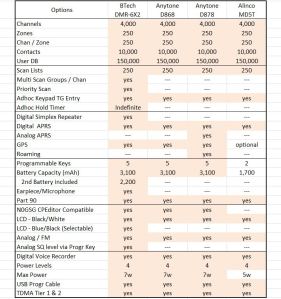
 Review – BTech AMP-25 series for Analog & DMR
Review – BTech AMP-25 series for Analog & DMR
The AMP-25 series VHF / UHF Amplifiers
The recently announced BTech Digital and Analog amplifier series puts a whole new spin on mobile operation. It performs more like a mobile than it does a power amp. The D series are true TDMA Tier2 DMR amplifiers.
Note: This review was done using an Anytone D868UV on both DMR and analog.
In the Box
Included with the 40W Mobile Amp are:
– Mounting Bracket
– 3′ Interface Control Cable (Kenwood K1 connectors)
– 3′ RF connect cable (SMA-M to SMA-F)
– Microphone and Hanger
– All necessary mounting hardware
– User Guide
General Description
– UHF or VHF Power Amplifier
– 2-6W > 20-40W Output
Modes of operation include:
| V25 U25 | V25D U25D |
| Analog (FM) C4FM (Fusion) P25 (Phase 1) NXDN IDAS dPMR MPT1327 | > DMR Tier II (TDMA) > P25 (Phase 2) Analog (FM) C4FM (Fusion) P25 (Phase 1) NXDN IDAS dPMR MPT1327 |
A Different type of Mobile Amplifier
I found these to be much more than a typical power amplifier. Although they can function as a simple ‘In and Out’ power amp, this is about as close to a full mobile as you can get. Although the driving  force was my DMR handheld sitting in my cup holder, the transmit audio was that of the included hand microphone and the receiver audio out was coming through the built in speaker driven by a four watt audio amplifier.
force was my DMR handheld sitting in my cup holder, the transmit audio was that of the included hand microphone and the receiver audio out was coming through the built in speaker driven by a four watt audio amplifier.
Transmit Power
I tested the power on two different models. The VHF V25 (non TDMA) and the U25D for UHF DMR. The power was tested using the analog side of both into a calibrated Bird Termaline wattmeter. The maximum current drain from my 13.6V 30A power supply was just under 6A. This is low enough for the amp to be powered by the 10A accessory jack in your vehicle.
Enclosure
The basic frame measures 4.6″W x 1.3″H x 5.5″D (excluding the SO-239) and weighs in at 26oz. I was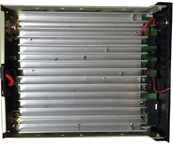 curious to see the internal layout of the amp and to no surprise, there was a 5/8″ finned heat sink spanning the entire length and width of the case along with air vent along the back of the enclosure.
curious to see the internal layout of the amp and to no surprise, there was a 5/8″ finned heat sink spanning the entire length and width of the case along with air vent along the back of the enclosure.
Operating Modes
These are single band amplifiers.
V25(D) = VHF 136-174MHz
U25(D) = UHF 400-480MHz.
Note: The V25D and U25D were designed to include DMR Tier II (TDMA) and P25 Phase 2 along with all other modes. Their operation varies slightly.
V25 / U25
To operate VHF through the UHF (U25) amplifier, or UHF through the VHF (V25) amplifier, simply power off the amplifier. This will allow you to run straight through directly to the antenna without power amplification on that band.
V25D / U25D
These amplifiers will only operate within their specified VHF or UHF range. This is due to the circuit switching design of DMR Tier II and P25 Phase 2.
Hook Up
The simplest configuration is using the included RF cable to attach the radio to the amp. You could add a Spkr/Micr to the handheld, but you would still be bypassing some of the best features.
I use the two included cables. The 3′ RF cable to attach the radio to the amp, and the control cable. This allows me to use the full size hand microphone as well as connecting the four watt audio amp powering the speaker. The power included power cable is compatible with handhelds using the standard two pin Kenwood style connector, such as an MD380, D868, GD77, UV5R, F8HP, UV82, etc.
allows me to use the full size hand microphone as well as connecting the four watt audio amp powering the speaker. The power included power cable is compatible with handhelds using the standard two pin Kenwood style connector, such as an MD380, D868, GD77, UV5R, F8HP, UV82, etc.
I use an Anytone D868 on DMR as well as analog with the hookup diagrammed below. Depending on your radios antenna jack, you may need to pickup an SMA-M to SMA-M adapter.
Convenience
All channel selection and volume adjustments are done using the handheld. No duplicate programming or code plugs are necessary. Whatever is in my handheld is what I operate in the mobile
Operating my handheld in the low power position, I still get 22W out on UHF and my handheld’s battery life remains excellent, but high power gives me a solid 39W.
Conclusion
I was glad to see someone finally develop what is a full featured mobile amplifier capable of DMR as well as all other modes including C4FM and D-Star that is small enough to mount in the car, boat, and on top of your computer. This amplifier is Part 90 certified and definitely worth considering.
Available from Amazon: V25 V25D U25 U25D
and ![]()

VHF /UHF
Digital / Analog
Mobile Power Amplifiers
![]()
![]()
 Review – BTech UV-50X3 (Tri-Band)
Review – BTech UV-50X3 (Tri-Band)
by John ‘Miklor’
Included with the radio are: 50X3 Weight: Main Chassis 2.1kg (4.6 lbs) Specifications The 50X3 is FCC Part 90 certified for commercial use in the US. Control Head The suction mount is about the best I’ve ever used. It requires a smooth metal or glass surface, but the silicon rubber cup will not let loose. My control head has been mounted atop my computer for over a month, and it is going nowhere. The button functions are displayed on the LCD screen for easy function identification. The PTT button on the upper right is for Momentary or Toggle PTT. One press turns the TX on, next press turns it off. Setting to Toggle is convenient if running a net or using a mobile headset. 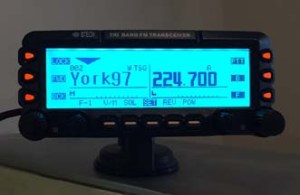 Cooling The 220 ham band transmit range is limited to 222-225MHz. The receiver is capable of being programmed above and below those frequencies, but may be outside of the performance range due to the ham band specific filtering.
Microphone The radio comes with a full function keypad style microphone. On the right side are two slide switches that control the Lock and Lamp feature, and on top of the microphone are two frequency Up and Down buttons. Along with a 16 button DTMF style keypad are 4 programmable function keys. Choices are Squelch Off, TX Power, Rptr Shift, Reverse, and Tone Call. There are two microphone input jacks. One on the control head, the other on the main unit. There is also a built in microphone element inside the control head. Although the audio quality is excellent, the sensitivity is that of a standard microphone. The OTA reports were excellent with plenty of audio, so there’s no reason to shout. A nice feature in the audio section is an adjustable microphone gain control. There are 5 settings available. Min, Low, Normal, High, and Max. Normal is great for speaking in a normal volume an inch from the microphone. Running a net with VOX and a headset, you can bring it up a bit. Driving in an off road vehicle, you just might need to set it back.
Receiver Along with the standard VHF / 220 / UHF frequencies, the receiver covers: 0.5-1.7 MHz (AM Radio) The control head has built in speakers, as well as one in the main module. An external speaker jack in the rear also allows for a larger speaker if desired. The jack provides for either mono or stereo output. (each receiver can have it’s own speaker). I found a menu setting to adjust the tone of the speaker as well. Although there is more than ample audio output, when the volume control is all the way down, the radio is silent, as it should be. Cross Band Repeat The radio takes full advantage of the independent receiver by including a Cross Band Repeat function. I entered the VHF and UHF frequencies, power level and tones, selected the Cross Band mode, and was ready to go. The audio levels are preset and the audio quality reports were excellent. Cross band repeating using a 220MHz frequency was not possible. This is more than likely a precaution due to the minimal frequency separation. Display The control head has a large 5″ LCD with your choice of background colors. Options include White-Blue, Sky-Blue, Marine-Blue, Green, Yellow-Green, Orange, Amber, and White. The brightness and contrast are also menu selectable.
Unless you are only entering a few channels, I would recommend the optional PC05 programming cable. The UV-50X3 uses the CHIRP programming software. Scanning in the VFO mode allowed me to scan either the VHF, 220MHz, or UHF band. In the Channel mode, the scan would select any channel in the list regardless of band. Power Cable There are radios that draw less power whose power cables use thinner wire, lower value fuses, and can be plugged into accessory plugs. Do NOT use these cables, even though they may be plug compatible. The 50X3 draws twice the current, and will blow the fuses and possibly overheat the wire. The cable on the 50X3 appears to match that of the hi-power Yaesu, Icom, Kenwood series. ONLY use the proper cable for the radio. Base Station Operation For mobile drive testing, I teamed this radio with a Nagoya Tri-Band TB320A and SB-35 NMO mag mount and the results were excellent. Conclusion Some of the added advantages to the US market are the FCC Part 90 certification, local US support, and exclusive program support using CHIRP software. The radio can also be shipped worldwide by contacting BTech directly. This is definitely one of the nicest mobile transceivers I’ve used; and yes, I’ve owned the “big 3”.
More Information: Miklor.com |
 Anytone Tech models, additional notes
Anytone Tech models, additional notes
Overall, reviewing these Anytones was a pleasant experience. After the reviews I looked into a few other things.
- The batteries of the ANILE-8R (1300 mAh) and the NSTIG-8R (1800 mAh) are exchangeable.
- The belt clips used on the ANILE-8R and NSTIG-8R are never a perfect fit. With the 1300 mAh battery there’s a gap (easy to lose a radio that way), with the 1800 mAh battery it’s too tight.
- The antenna on the NSTIG-8R heats up fast at maximum RF output; the behavior resembles that of a Baofeng UV-5R stock antenna. The antenna appears to be reasonably efficient though. More tests are in order.
- No such problems with the antennas of the ANILE-8R, the TERMN-8R or OBLTR-8R.
- The NSTIG-8R, TERMN-8R and OBLTR-8R can display the remaining battery voltage. Measurements show that the radios are surprisingly accurate. If the radios say “8.1 Volts”, it really is 8.1 Volts. The ANILE-8R will round it down/up to the closest integer.
- The OBLTR-8R is difficult to use on SW because it defaults to 10 KHz steps. SW stations are 5 KHz apart, not 10 KHz. You can use the keypad to enter the correct frequency though. I had the bug confirmed by John; it’s now on the ‘to do’ list and will be fixed.
- The more I had the TX audio compared by other hams, the more impressed I (and they) became.
- There’s an odd problem concerning spectral purity with all x-band capable hand helds I reviewed. It only occurs when both VFOs are active; we (me and a few more knowledgeable RF lab gurus) are looking into that right now.
 Anytone Tech models, additional notes
Anytone Tech models, additional notes
Overall, reviewing these Anytones was a pleasant experience. After the reviews I looked into a few other things.
- The batteries of the ANILE-8R (1300 mAh) and the NSTIG-8R (1800 mAh) are exchangeable.
- The belt clips used on the ANILE-8R and NSTIG-8R are never a perfect fit. With the 1300 mAh battery there’s a gap (easy to lose a radio that way), with the 1800 mAh battery it’s too tight.
- The antenna on the NSTIG-8R heats up fast at maximum RF output; the behavior resembles that of a Baofeng UV-5R stock antenna. The antenna appears to be reasonably efficient though. More tests are in order.
- No such problems with the antennas of the ANILE-8R, the TERMN-8R or OBLTR-8R.
- The NSTIG-8R, TERMN-8R and OBLTR-8R can display the remaining battery voltage. Measurements show that the radios are surprisingly accurate. If the radios say “8.1 Volts”, it really is 8.1 Volts. The ANILE-8R will round it down/up to the closest integer.
- The TERMN-8R is difficult to use on SW because it defaults to 10 KHz steps. SW stations are 5 KHz apart, not 10 KHz. You can use the keypad to enter the correct frequency though. I had the bug confirmed by John; it’s now on the ‘to do’ list and will be fixed.
- The more I had the TX audio compared by other hams, the more impressed I (and they) became.
- There’s an odd problem concerning spectral purity with all x-band capable hand helds I reviewed. It only occurs when both VFOs are active; we (me and a few more knowledgeable RF lab gurus) are looking into that right now.
 Review Anytone NSTIG-8R
Review Anytone NSTIG-8R
 The NSTIG-8R was the first radio I tried out, mainly because it came with a fully charged battery. I punched in some frequencies and took off on a 5-mile walk. The radio performed quite well.
The NSTIG-8R was the first radio I tried out, mainly because it came with a fully charged battery. I punched in some frequencies and took off on a 5-mile walk. The radio performed quite well.
In the box:
- Radio
- 1800 mAh battery
- Antenna (SMA female)
- Simple headset
- Charger
- AC adapter (110-240 Volts)
- Belt clip
- Wrist strap
- Manual
Factory specifications
Frequency range: [TX/RX] 136 – 174MHz, 400 – 520MHz
RX only: 68-108MHz (FM Broadcast)
Channel Capacity: 200 Channels
Channel Spacing: 25KHz (wide band)12.5KHz (narrow band)
Sensitivity: ≤0.25μV (wide band) ≤0.35μV (narrow band)
Operation Voltage: 7.4V DC ±20%
Battery: 1800mAh
Frequency steps (KHz): 2.5, 5, 6.25, 10, 12.5, 20, 25, 30 and 50
Antenna: SMA-Female
Accessory Connector: Kenwood 2-Pin standard
Stability: ±2.5 ppm
Output power: 5W / 1W
Size: 113×62×40mm (with battery)
Weight: 220g (with battery, antenna, belt clip)
Audio Power Output: 1000mW
Build quality
The first thing I noticed is the weight of the NSTIG-8R. While the dimensions of the radio are nearly identical to those of a UV-5R, this radio is quite a bit heavier: 129 grams vs 91 grams (without battery and antenna). With all the bells & whistles attached the scale shows 240 grams vs 209 grams. All in all the radio has a solid feel to it.
Side keys
The NSTIG-8R has three side keys also, and these can be programmed by the user. At default the upper key will switch on the flashlight, the middle one will show you the remaining battery voltage, and the last one will bypass the squelch (monitor).
Dual PTT
If you like you can reprogram one of the side keys to function as PTT for VFO B. The main PTT key is reserved for VFO A and can’t be re-assigned.
Display
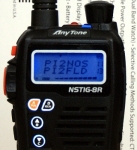 At default the three-color display (amber, blue or purple) shows two frequencies at the same time and will be in dual watch mode. There’s no ‘TDR’ option in the menu; if you want to switch off dual watch you press Function+Main to toggle between dual watch and single band mode.
At default the three-color display (amber, blue or purple) shows two frequencies at the same time and will be in dual watch mode. There’s no ‘TDR’ option in the menu; if you want to switch off dual watch you press Function+Main to toggle between dual watch and single band mode.
In single band mode you can switch between VFO A en B by just pressing the Main key. The system takes a little bit time to get used to.
 Nice touch: even when attached to your belt you can see which VFO is active. When the RX LED turns green the upper VFO is active, when turning blue the lower VFO is active. Contrary to a Baofeng you can select VFO mode or memory mode for each individual VFO.
Nice touch: even when attached to your belt you can see which VFO is active. When the RX LED turns green the upper VFO is active, when turning blue the lower VFO is active. Contrary to a Baofeng you can select VFO mode or memory mode for each individual VFO.
The S-meter is one that actually works. Meters on hand helds are never accurate enough to give a meaningful signal report, but at least you get a basic idea of the field strength.
Programming
Most of the programming can be done from the keypad, including alpha tags. The software is necessary to change the welcome message, or give the radio its own ID and pre-programmed DTMF sequences — something you will need if you decide to use individual or group calling. You can do a lot manually, which will come in handy in the field, but using the software will work faster and give you access to a lot of other options.
I think it’s really a shame that there’s no Help section in the software. With basic channel-editing software I couldn’t care less, but this program offers quite a few exotic options. I guess that figuring it all out will be left to us, after which we can document it on Miklor.com.
Memories
You can program 200 VHF/UHF frequencies and 99 FM broadcast frequencies. I won’t be able to fill that up easily, but I’m sure there will be others who won’t have any problems filling these up to the max.
Scanning
Most Chinese radios are poor, painfully slow scanners. For the first time in years I can report that scan speed is actually acceptable: about 4-5 channels/second. Not brilliant, but usable. The top models in the 8R series have a Fast Scan mode which clocks at 10 channels/second.
The NSTIG-8R can scan for CTCSS/DCS codes, and you can set VFO scanning limits.
Bugs
Haven’t been able to find one.
Various measurements
TX audio: loud and clear, just like the ANILE-8R. No complaints.
RX audio: Same story: loud and clear, with no noticeable distortion.
Sensitivity VHF (@ 145 MHz): -127 dBm (@ 50Ω, 12 dB SINAD).
Sensitivity UHF (@ 435 MHz): -125 dBm (@ 50Ω, 12 dB SINAD).
Frequency accuracy of this sample: VHF: 0 Hz, UHF -13 Hz.
Power output VHF (@145 MHz): 1.3 Watts / 4.9 Watts.
Power output UHF (@435 MHz): 1.1 Watts / 4.3 Watts.
Front-end: good, but not as good as the Wouxun KG-UV6D or QuanSheng TG-UV2.
Harmonic suppression: three measurable harmonics on VHF, varying between -53.05 dBm and -60.20 dBm, on UHF there’s only one at -57.33 dBm.
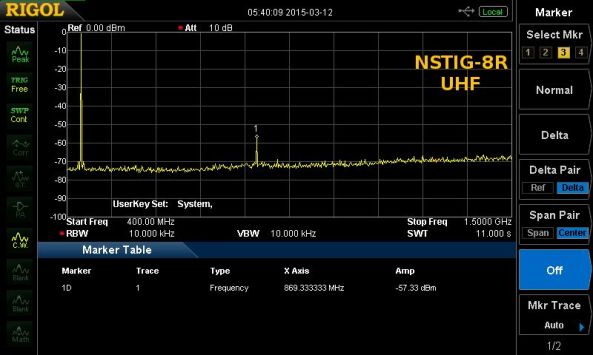 Conclusion
Conclusion
I really like the NSTIG-8R. The design is refreshing, the radio offers more functionality than the average low cost radio, and it’s built like a tank.
The price of the radio is twice that of a Baofeng and half that of a basic(*) Yaesu FT-60. I understand people muttering about prices (it’s the first thing we hams do, it must be in our DNA), but the relation between price and quality is right on target here.
There’s always a choice: you go for the cheapest, for the best, or for something in between. Seen from that perspective the NSTIG-8R nicely fills the gap between Baofengs and Yaesu’s entry level radio.
(*) The Yaesu FT-60 does not come with a desktop charger, 1800 mAh battery or headset – you need to add about $120 for these accessories)
Price: $68.89 (Amazon)
More information: Anytone Tech
 Review Anytone ANILE-8R
Review Anytone ANILE-8R
 The ANILE-8R was not the first Anytone Tech model I unpacked, but it will be the first to be reviewed thanks to its simplicity.
The ANILE-8R was not the first Anytone Tech model I unpacked, but it will be the first to be reviewed thanks to its simplicity.
Baofeng vs Anytone
In terms of design this radio resembles the Baofeng BF-666S/BF-777S/BF-888S series: 16 channels, no thrills no frills, no display – just on/off/volume, a flashlight and a 16-channel selector. Both radios tell you which channel is active by using a speech processor. Based on this the two radios could be regarded as competitors.
I kept my Baofeng BF-666S in spite of its generous amount of flaws: the receiver can be trashed by about any out-of-band signal or mixer product, the oscillator isn’t stable (phase noise, which causes reciprocal mixing), and RX audio sounds raw, unfinished even. TX audio however is fine, battery life is great, and the price (below $20) is hard to beat.
The consequence of Baofeng’s cheap design is that I only can use the radio when I’m far enough away from any RF pollution. As you can imagine I was very curious if the ANILE-8R would outperform the Baofeng or not.
In the box
The radio, antenna, 7.4 Volts 1300 mAh battery, charger, power adapter, headset, small strap, manual.
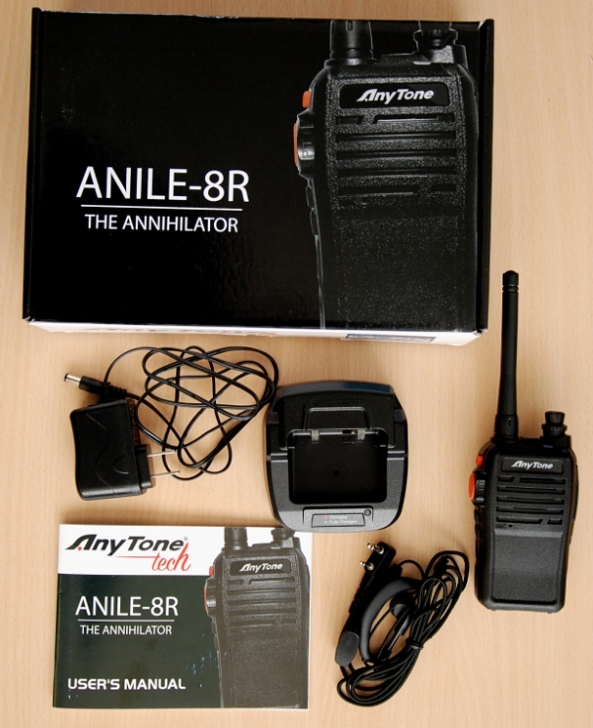 Build quality
Build quality
These radios are ideal for outdoor activities, because there’s not much you can break. The Baofeng already did well, but the Anytone feels much sturdier. It’s well built.
Side keys
There are three side keys and you can program them yourself. At default the upper key will switch on the flashlight, the middle one will tell you the remaining battery voltage, and the last one will bypass the squelch (monitor).
Programming options
Scanning, priority channel selection, CTCSS, DCS, and DTMF calling methods (individual or group calls).
Phase noise
The first thing I looked at was phase noise. During instruction evenings I use the Baofeng as the prime example of poor design; all I could hope for was that Anytone did a better job. They did.
The first image shows the Baofeng (notice the wide ‘shoulders’ which shouldn’t be there), the second image is the Anytone. I slightly zoomed in on the Anytone carrier to get a better view.
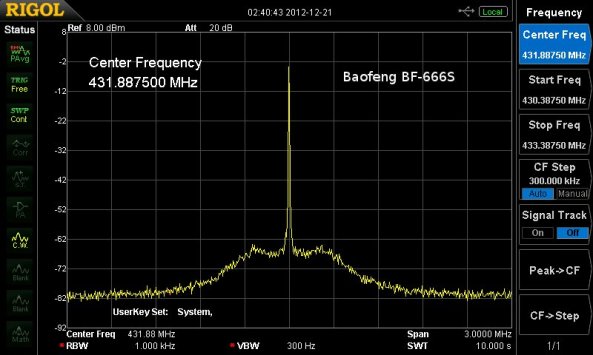
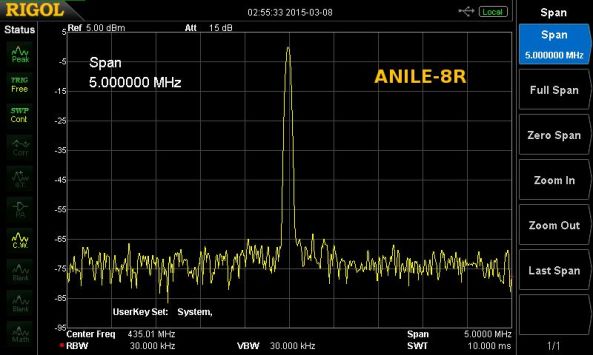
Harmonics
The Baofeng has no detectable harmonics, the ANILE-8R has one at -57.62 dBm. It’s just short of the -60 dBm I like to see, but nothing to worry about.
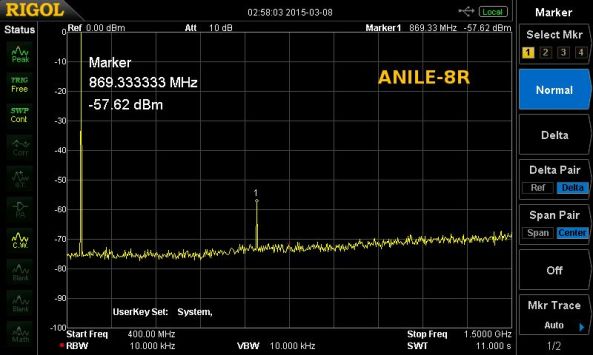
TX audio: loud and clear, just excellent. The most memorable quote from a listener was “I can’t tell the difference between this one and your gear at home.”
RX audio: Same story: loud and clear, with no noticeable distortion.
Sensitivity (@ 435 MHz): -125 dBm (@ 50Ω, 12 dB SINAD).
Frequency accuracy of this sample: -26 Hz.
Power output (@435 MHz): 1.2 Watts / 4.2 Watts.
Front-end: good. Unlike the Baofeng, the receiver doesn’t collapse quickly.
Bugs:
I noticed that RX audio muted when I switched on the flashlight. Audio stayed muted while a signal was present. Audio came back after:
- the carrier dropped and returned
- pressing PTT or one of the side keys.
Toggling the flashlight on/off had no influence.
I forwarded the bug to John K3NXU (Miklor) and the owner of Anytone Tech. It didn’t take long before my findings were confirmed. However, a few days later I found an option in the software which caught my eye: “Eliminate Squelch Tail When No CTCSS/DCS Signaling”. The default value was 55.2 Hz. When set to ‘Off’, the strange influence of the flashlight on reception is gone. Problem solved.
Conclusion:
Anytone Tech’s ANILE-8R is a very good radio and can make you forget the Baofeng BF series. Only when I start nitpicking I could make a remark about the belt clip. It didn’t seem to be designed for this radio, as there was quite a gap between the clip and the battery. I solved the problem by bending it a little bit.
Price: $46.99 (Amazon)
More information: Anytone Tech.
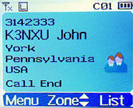




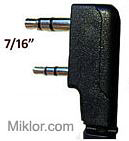


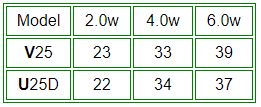

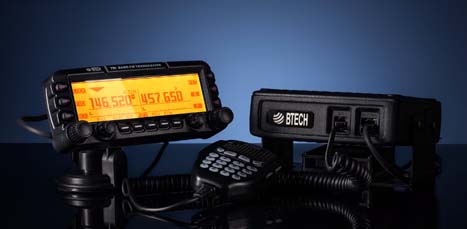 Four years after its initial design, the VGC 6600PRO has evolved into the BTech UV-50X3, a full featured Tri-Band mobile that delivers a full 50W on VHF and UHF, with addition of a 220 MHz module that delivers 5W output. The 220 MHz module was specifically designed and filtered for 222-225MHz US ham band operation. I mention this as there are currently radios being advertised as Tri-Band operating in the range of 240-260MHz that are not adaptable to frequencies below 240MHz due to their internal filtering.
Four years after its initial design, the VGC 6600PRO has evolved into the BTech UV-50X3, a full featured Tri-Band mobile that delivers a full 50W on VHF and UHF, with addition of a 220 MHz module that delivers 5W output. The 220 MHz module was specifically designed and filtered for 222-225MHz US ham band operation. I mention this as there are currently radios being advertised as Tri-Band operating in the range of 240-260MHz that are not adaptable to frequencies below 240MHz due to their internal filtering.
